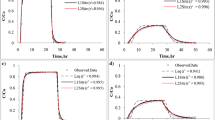Abstract
The sorption behaviors of pollutants affected by hydrodynamic conditions were confirmed in natural water environment. The effects of hydrodynamic conditions on the sorption behaviors of aniline on sediment with coexistence of nitrobenzene were investigated. The particle entrainment simulator (PES) was used to simulate varied bottom shear stresses. The batch equilibrium method was applied to the experiments with the stress levels and the action time controlled at 0.2–0.5 N/m2 and 24 h, respectively. The findings indicated that apparent partition coefficient of aniline on sediment increased with the shear stress significantly, while decreased with nitrobenzene concentration. On the contrary, both the sorption amount of aniline on suspended particulate matter (Q s) and the effect of nitrobenzene concentration on Q s declined as the shear stress increased. The sorption kinetic results showed that the sorption process followed the pseudo-second-order kinetics equation, and the process included two stages: fast sorption stage and slow sorption stage, among which the average sorption rate of fast stage was 7.5–9.5 times that of slow one. The effect of shear stress on the average sorption rate of aniline was enhanced with the increase of nitrobenzene concentration. And shear stress weakened the disturbance of cosolute on main solute sorption process. In addition, experiment results of sorption kinetic show that only the initial sorption rate was affected by shear stress and cosolute concentration. In the first 5 min, shear stress had positive effects on the sorption rate. After that, the sorption rate barely changed with shear stress and cosolute concentration.







Similar content being viewed by others
References
Arp HPH, Breedveld GD, Cornelissen G (2009) Estimating the in situ sediment—porewater distribution of PAHs and chlorinated aromatic hydrocarbons in anthropogenic impacted sediments. Environ Sci Technol 43:5576–5585
Blackburn TH (1997) Release of nitrogen compounds following resuspension of sediment: model predictions. J Mar Syst 11:343–352
Blom G, Winkels HJ (1998) Modelling sediment accumulation and dispersion of contaminants in Lake Ijsselmeer (The Netherlands). Water Sci Technol 37:17–24
Briggs GG (1981) Theoretical and experimental relationships between soil adsorption, octanol–water partition coefficients, water solubilities, bioconcentration factors, and the parachor. J Agric Food Chem 29:1050–1059
Cantwell MG, Burgess RM (2004) Variability of parameters measured during the resuspension of sediments with a particle entrainment simulator. Chemosphere 56:51–58
Cantwell MG, Burgess RM, Kester DR (2002) Release and phase partitioning of metals from anoxic estuarine sediments during periods of simulated resuspension. Environ Sci Technol 36:5328–5334
Chiou CT, Peters LJ, Freed VH (1979) A physical concept of soil–water equilibria for nonionic organic compounds. Science 206:831–832
Conkle JL, Lattao C, White JR, Cook RL (2010) Competitive sorption and desorption behavior for three fluoroquinolone antibiotics in a wastewater treatment wetland soil. Chemosphere 80:1353–1359
Cornelissen G, Gustafsson O, Bucheli TD, Jonker MTO, Koelmans AA, van Noort PCM (2005) Extensive sorption of organic compounds to black carbon, coal, and kerogen in sediments and soils: mechanisms and consequences for distribution, bioaccumulation, and biodegradation. Environ Sci Technol 39:6881–6895
Fang CR, Long YY, Shen DS (2014) Sorption behavior of dibutyl phthalate and dioctyl phthalate by aged refuse. Environ Sci Pollut R 21:7641–7649
Feng JL, Yang ZF, Niu JF, Shen ZY (2007) Remobilization of polycyclic aromatic hydrocarbons during the resuspension of Yangtze River sediments using a particle entrainment simulator. Environ Pollut 149:193–200
Folberth C, Suhadolc M, Scherb H, Munch JC, Schroll R (2009) Batch experiments versus soil pore water extraction—What makes the difference in isoproturon (bio-)availability? Chemosphere 77:756–763
Gabel F, Garcia XF, Schnauder I, Pusch MT (2012) Effects of ship-induced waves on littoral benthic invertebrates. Freshw Biol 57:2425–2435
Grundtner A, Gupta S, Bloom P (2014) River bank materials as a source and as carriers of phosphorus to Lake Pepin. J Environ Qual 43:1991–2001
Hari AC, Paruchuri RA, Sabatini DA, Kibbey TC (2005) Effects of pH and cationic and nonionic surfactants on the adsorption of pharmaceuticals to a natural aquifer material. Environ Sci Technol 39:2592–2598
Hassett JP (2006) Chemistry. Dissolved natural organic matter as a microreactor. Science 311:1723–1724
Hawthorne SB, Grabanski CB, Miller DJ (2006) Measured partitioning coefficients for parent and alkyl polycyclic aromatic hydrocarbons in 114 historically contaminated sediments: part 1. K-OC values. Environ Toxicol Chem 25:2901–2911
Heringa MB, Hermens JLM (2003) Measurement of free concentrations using negligible depletion-solid phase microextraction (nd-SPME). Trac Trend Anal Chem 22:575–587
Hu KM, Pang Y, Wang H, Wang X, Wu X, Bao K, Liu Q (2011) Simulation study on water quality based on sediment release flume experiment in Lake Taihu, China. Ecol Eng 37:607–615
Hu R, Wang X, Dai S, Shao D, Hayat T, Alsaedi A (2015) Application of graphitic carbon nitride for the removal of Pb(II) and aniline from aqueous solutions. Chem Eng J 260:469–477
Jadhav AJ, Srivastava VC (2013) Adsorbed solution theory based modeling of binary adsorption of nitrobenzene, aniline and phenol onto granulated activated carbon. Chem Eng J 299:450–459
Kim LH, Choi E, Stenstrom MK (2003) Sediment characteristics, phosphorus types and phosphorus release rates between river and lake sediments. Chemosphere 50:53–61
Kurt Z, Shin K, Spain JC (2012) Biodegradation of chlorobenzene and nitrobenzene at interfaces between sediment and water. Environ Sci Technol 46:11829–11835
Latimer JS, Davis WR, Keith DJ (1999) Mobilization of PAHs and PCBs from in-place contaminated marine sediments during simulated resuspension events. Estuar Coast Shelf Sci 49:577–595
Liu N, Li H, Ding F, Xiu Z, Liu P, Yu Y (2013) Analysis of biodegradation by-products of nitrobenzene and aniline mixture by a cold-tolerant microbial consortium. J Hazard Mater 260:323–329
Ma J, Zhu L (2006) Simultaneous sorption of phosphate and phenanthrene to inorgano–organo-bentonite from water. J Hazard Mater 136:982–988
Miller SM, Hornbuckle KC (2010) Spatial and temporal variations of persistent organic pollutants impacted by episodic sediment resuspension in southern Lake Michigan. J Great Lakes Res 36:256–266
OECD (2000) OECD guideline 106 - OECD guideline for the testing of chemicals: adsorption–desorption using a batch equilibrium method
Reardon KE, Bombardelli FA, Moreno-Casas PA, Rueda FJ, Schladow SG (2014) Wind-driven nearshore sediment resuspension in a deep lake during winter. Water Resour Res 50:8826–8844
Tsai CH, Lick W (1986) A portable device for measuring sediment resuspension. J Great Lakes Res 12:314–321
Wang S, Jin X, Bu Q, Jiao L, Wu F (2008) Effects of dissolved oxygen supply level on phosphorus release from lake sediments. Colloids Surf A 316:245–252
Wang S, Jin X, Zhao H, Wu F (2009) Phosphorus release characteristics of different trophic lake sediments under simulative disturbing conditions. J Hazard Mater 161:1551–1559
Wang P, Wang SY, Hao SP, Yao Q, Tang LL (2010) Characteristics of sediment resuspension in Taihu Lake under simulative disturbing conditions. Adv Water Sci 21:399–404 (In Chinese)
Wang H, Holden J, Spera K, Xu XH, Wang ZD, Luan JH, Xin X, Zhang ZJ (2013a) Phosphorus fluxes at the sediment–water interface in subtropical wetlands subjected to experimental warming: a microcosm study. Chemosphere 90:1794–1804
Wang P, Shen X, Wang SY, Hao SP (2013b) Remobilization of phosphorus from sediments of Taihu Lake during periods of simulated resuspension. Water Environ Res 85:2209–2215
Wu D, Hua ZL (2014) The effect of vegetation on sediment resuspension and phosphorus release under hydrodynamic disturbance in shallow lakes. Ecol Eng 69:55–62
Zeng T, Ziegelgruber KL, Chin YP, Arnold WA (2011) Pesticide processing potential in prairie pothole porewaters. Environ Sci Technol 45:6814–6822
Zeng T, Chin YP, Arnold WA (2012) Potential for abiotic reduction of pesticides in prairie pothole porewaters. Environ Sci Technol 46:3177–3187
Zhang XY, Wu YG, Hu SH, Lu C, Yao HR (2014) Responses of kinetics and capacity of phenanthrene sorption on sediments to soil organic matter releasing. Environ Sci Pollut R 21:8271–8283
Zhao Q, Weise L, Li PJ, Yang K, Zhang YQ, Dong DB, Li P, Li XJ (2010) Ageing behavior of phenanthrene and pyrene in soils: a study using sodium dodecylbenzenesulfonate extraction. J Hazard Mater 183:881–887
Acknowledgments
This research was financially supported by the State Major Project of Water Pollution Control and Management (2014ZX07101-011), the Priority Academic Program Development of Jiangsu Higher Education Institutions (PAPD), and Qing Lan Project.
Author information
Authors and Affiliations
Corresponding author
Additional information
Responsible editor: Hongwen Sun
Rights and permissions
About this article
Cite this article
Wang, P., Hua, Z., Cai, Y. et al. Effects of hydrodynamic conditions on the sorption behaviors of aniline on sediment with coexistence of nitrobenzene. Environ Sci Pollut Res 22, 11595–11605 (2015). https://doi.org/10.1007/s11356-015-4399-5
Received:
Accepted:
Published:
Issue Date:
DOI: https://doi.org/10.1007/s11356-015-4399-5




